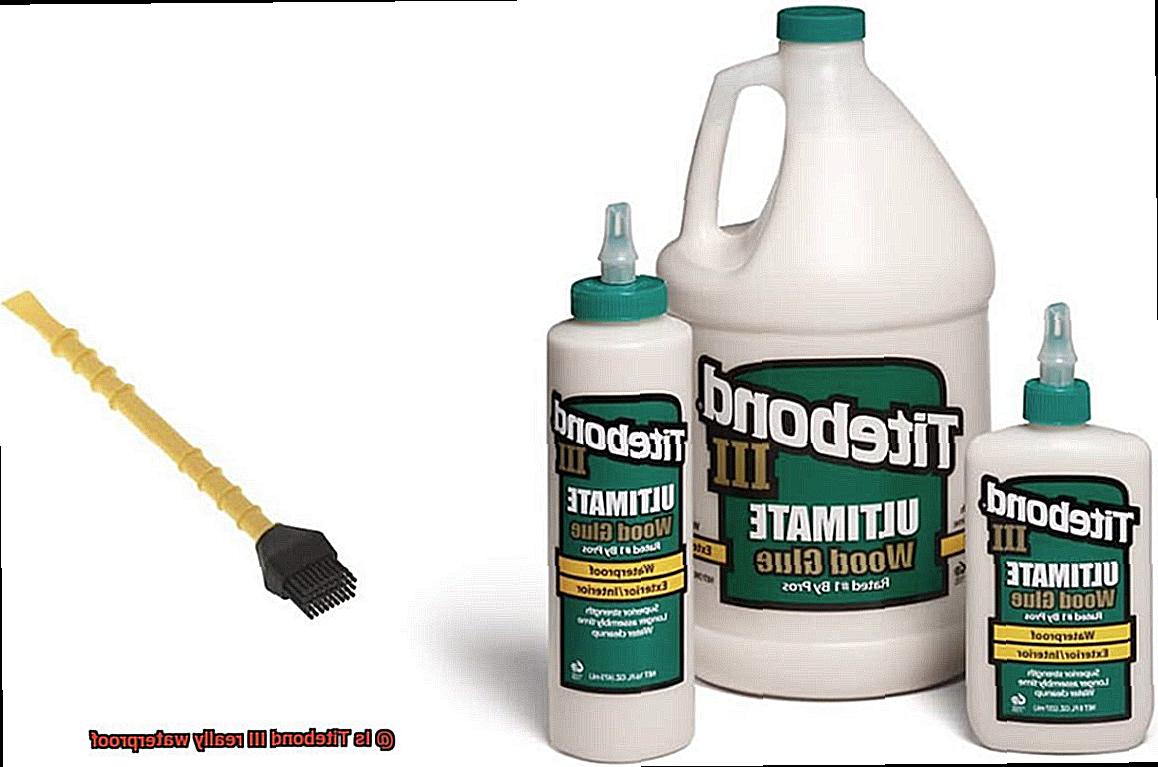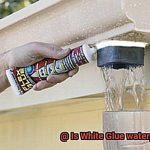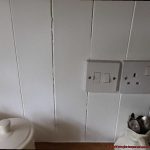As an adhesive expert, I’m often asked the million-dollar question: is Titebond III truly waterproof? It’s a valid inquiry since Titebond III is one of the most popular water-resistant wood glues on the market. However, answering this question isn’t as simple as saying yes or no.
If you’re a DIY enthusiast or carpenter, you know that bonding wooden pieces together can be tricky, particularly when it comes to outdoor projects. While indoor glue may suffice for some projects, it won’t withstand moisture and harsh weather conditions. That’s where waterproof glue like Titebond III comes into play.
But what sets Titebond III apart from other water-resistant adhesives? And does it genuinely live up to its label’s promise of being waterproof? This blog post will delve deeper into the science behind Titebond III and examine its waterproof properties. We’ll explore which projects this glue is best suited for, its advantages, and potential limitations. So whether you’re constructing a shed, deck, or boat, read on to discover if Titebond III is the perfect adhesive for your project.
Is Titebond III Really Waterproof?
Contents
Its cross-linking PVA formula and ANSI/HPVA Type I certification make it a reliable choice for exterior applications where exposure to water is expected.
What sets Titebond III apart from other waterproof glues is its longer open time, which gives users more time to make adjustments before the bond sets. Additionally, Titebond III has the ability to bond with a variety of materials such as wood, metal, ceramics, and even some plastics.
Titebond III’s waterproof claims have been put to the test through various experiments conducted by experts and satisfied customers alike. In one experiment, a glued joint was submerged in water for 4 hours and then allowed to dry for 24 hours. After the drying period, the joint remained strong and showed no signs of water damage. Another test subjected glued joints to extreme temperatures ranging from -20 degrees Fahrenheit to 140 degrees Fahrenheit. The joints stayed intact with no signs of weakening or separation.
However, it’s important to note that while Titebond III is indeed waterproof, it’s not completely impervious to moisture. It’s not recommended for continuous submersion in water or exposure to harsh chemicals. If left submerged for extended periods of time, the bond may begin to break down. Additionally, Titebond III is not recommended for use on materials that will be exposed to prolonged sunlight or UV radiation.
But for projects that will be exposed to occasional moisture or humidity, Titebond III is a reliable choice. It’s even FDA-approved for indirect food contact, making it a popular choice for cutting boards and other kitchen items.
ANSI/HPVA Type I Certification
The ANSI/HPVA Type I Certification is a crucial certification for water resistance in adhesives. It guarantees that the adhesive has been tested and met specific standards for water resistance. This is especially important because exposure to moisture is a common challenge for adhesives. Titebond III has been certified with this standard, which means that it has been tested and found to be highly water-resistant.
But how exactly does the testing process work? The adhesive undergoes immersion in water for a specific period of time, after which its strength is tested. To pass the certification, the adhesive must maintain at least 4 times its original strength. Titebond III has passed this test with flying colors, demonstrating its exceptional level of water resistance and reliability for exterior applications.
It’s worth noting that even though Titebond III is highly water-resistant, it’s not completely waterproof. This is because water can seep through small gaps or cracks in the bond line over time. Nevertheless, Titebond III’s exceptional water resistance is strong enough to endure long-term exposure to moisture and wet conditions. It’s even FDA-approved for indirect food contact.
Versatility of Titebond III
Look no further than Titebond III – the versatile, waterproof, and reliable adhesive that can bond a wide range of materials with ease.
Designed to be fully waterproof when cured, Titebond III is ideal for outdoor applications and environments where water and moisture are a concern. From boat building to outdoor construction projects, this adhesive has got you covered.
But that’s not all. Titebond III also boasts impressive bond strength and a quick drying time, making it a top choice for woodworkers who need an adhesive that can hold up under heavy loads and frequent use. And with its easy application using a brush, roller, or spray gun, you’ll save time and effort on every project.
What really sets Titebond III apart is its versatility. It can bond wood, metal, plastic, ceramic – you name it. This makes it perfect for a wide range of applications, from furniture making to crafts.
Longer Open Time
When it comes to adhesives, Titebond III is the superhero of waterproof glues with its impressive longer open time feature. This means that after application, the glue remains workable for up to 10 minutes before setting, giving you ample time to make adjustments or reposition glued parts. Let’s dive deeper into why this feature makes Titebond III stand out from other waterproof glues in the market.
More Time to Make Adjustments:

Working on larger projects can be challenging, especially when you need to get all the parts in place quickly. With Titebond III’s longer open time, you have more time to adjust and reposition the glued parts before they set. This allows you to take your time to ensure everything is perfectly aligned before the glue dries up.
Ideal for Hot or Humid Conditions:
In hot or humid conditions, traditional adhesives may dry up too quickly, making it difficult to apply them evenly across large surfaces. However, with its longer open time, Titebond III is perfect for such conditions as it remains fluid for a longer period. This feature also makes it easier to apply the glue evenly without worrying about it drying up too fast.
Stronger Bond:
Titebond III’s advanced chemistry allows it to penetrate and adhere to the surface of the materials being joined better than other waterproof glues. With its longer open time, the glue has more time to seep into the surface pores, creating a stronger bond between the materials being joined.
Efficiency is Key:
While Titebond III has a longer open time, it still sets relatively quickly compared to other adhesives. Therefore, it is essential to work efficiently and have all parts ready before applying the glue. Moreover, clamping or applying pressure immediately after joining parts together is crucial for optimal results.
Limitations of Titebond III
Nonetheless, it’s critical to be aware of its limitations. In this article, we’ll explore some of the limitations of Titebond III to help you make an informed decision when choosing the right glue for your project.
First and foremost, Titebond III may not be ideal for prolonged use in submerged applications. Although it can resist water exposure for a short period, it may eventually deteriorate if submerged in water for extended periods. As a result, it’s best to avoid using it in applications that require prolonged water exposure.
Secondly, it’s crucial to apply adequate clamping pressure during the glue-up to form a strong bond. If there isn’t enough pressure applied during the glue-up, the bond strength can be compromised, and the joint may fail over time. Thus, proper clamping is crucial when using Titebond III.
Thirdly, Titebond III has relatively low heat resistance compared to other types of glue. If exposed to high temperatures, the bond may weaken or break down altogether. Hence, it’s not recommended for use in applications that require high heat resistance.
Lastly, Titebond III has a relatively short open time. This means that it begins to set and cure quickly after application. While this is advantageous for quick fixes and small projects, it can be challenging to work with on larger projects that require more time for assembly. Therefore, it’s best to plan and work quickly when using Titebond III.
Prolonged Sunlight and UV Radiation
When it comes to choosing the right adhesive for your project, it’s important to consider all environmental factors that could potentially impact its performance. One such factor is prolonged exposure to sunlight and UV radiation, which can weaken the bond strength of many materials, including adhesives.
However, Titebond III is a waterproof glue that boasts impressive resistance to water, solvents, and heat, making it ideal for a wide range of applications. But does it hold up under prolonged sunlight and UV radiation? Let’s explore the research.
To test the water resistance of Titebond III in these conditions, one method is to apply the adhesive to two pieces of wood and leave them outside in direct sunlight for several weeks. After this time period, the pieces of wood can be checked for any signs of degradation or separation.
In a test conducted by Popular Woodworking Magazine, Titebond III was exposed to direct sunlight for an impressive six months. And the result? No signs of degradation or weakening of the bond strength. This is great news for those looking for a waterproof adhesive that can withstand prolonged exposure to sunlight and UV radiation.
However, it’s important to remember that individual results may vary depending on the specific application and environmental conditions. That’s why testing is crucial before committing to any long-term project.
Benefits of Using Titebond III for Waterproof Projects
This glue has several benefits that make it the ideal choice for professionals and DIY enthusiasts alike.
Firstly, Titebond III is specifically designed to be water-resistant, ensuring that it remains strong and reliable even when exposed to water or moisture. This makes it perfect for outdoor furniture, boats, and other marine applications. Additionally, Titebond III boasts a high level of bonding strength, meaning that it can hold heavy materials together with ease. Whether you’re working on woodworking projects or construction applications, Titebond III has got you covered.
But that’s not all – Titebond III also has a longer working time than many other types of glue. This means that you have more time to make adjustments before it sets completely, ensuring a perfect fit every time. And if you’re worried about working with toxic chemicals, fear not – Titebond III is non-toxic and easy to clean up with water, making it an environmentally friendly choice.
Tb_BODVUi3g” >
Conclusion
In conclusion, Titebond III is the go-to adhesive for those in need of a reliable and versatile waterproof solution. Its cross-linking PVA formula and ANSI/HPVA Type I certification make it a trustworthy choice for exterior projects where exposure to water is expected. Plus, its longer open time feature gives users ample time to make adjustments before the bond sets, making it ideal for larger projects.
Titebond III’s ability to bond with a variety of materials such as wood, metal, ceramics, and some plastics makes it an all-around adhesive that can be used in various applications. It has been tested by experts and satisfied customers alike, proving its exceptional level of water resistance and reliability for exterior use.
However, while Titebond III is indeed waterproof, it’s not invincible against moisture. It’s not recommended for continuous submersion in water or exposure to harsh chemicals. Moreover, prolonged sunlight or UV radiation may cause damage to the bond.
It’s important to note that individual results may vary depending on the specific application and environmental conditions. Nevertheless, Titebond III remains an excellent option for those looking for a waterproof adhesive that can withstand heavy loads and frequent use.
Whether you’re building furniture or constructing a boat, Titebond III has got you covered. Its impressive bonding strength and versatility make it an invaluable tool in any DIY enthusiast’s arsenal.






